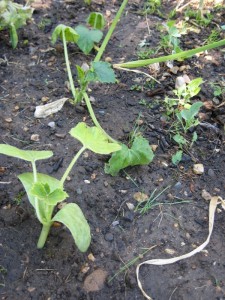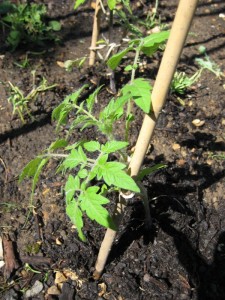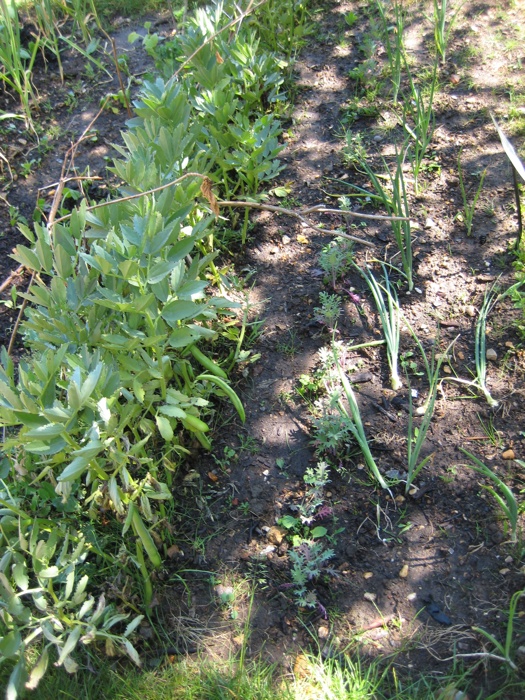On 03/06/2010 the Allotment Plot was experiencing another bright sunny day the temperature was significantly warm. The ground was desperately dry. Ella Montt who is the grower on this particular Allotment, sits next to the Plot and eats lunch in the shade of the Mulberry tree; the gaze drifts from the vegetable plot to cross the grass, resting on the Museum building, which houses the archives. The shelves of the Library within the Museum have many texts written about growing processes to be employed by growers. The contemplation of the books that contain texts is acted out on the Allotment Plot. Much is there within the archives to be discovered about the historic process of farming, land usage, plants, crops, the effects of industrialization and science.
Allotment history in the British Isles has slowly evolved and punctuates dates of social change. Before industrialized farming methods land to grow food was essential for individual and family survival, (as remains so now in many parts of the world). The medieval systems that was common through out Europe, enabled peasants, or the rural poor, to work portions of ground belonging to the Landowners in exchange for labouring for the landowner. The head of state of the particular country ultimately owned all land.
The enclosures acts, (formerly know as ‘Inclosure’) that started in Britain during the twelfth century, accelerated between the eighteenth and nineteenth century to gradually remove land access from the general population so that most workable land was owned by a limited number of people. Many cottagers or small holders lost their homes, because they could not retain their rights to their properties, poverty and famine followed. Common land that had been previously used by rural dwellers for fuel gathering and food cultivation, was lost. Landowners did not want the workers to have access to land to grow their own food because self-sufficiency meant that they would not need to work for the landowner. Because people no longer had ways to support themselves, there was a movement of the rural poor to the towns, here they were able to become workers in the factories. The rural moved to the urban, yet the urban needed the rural in order to cultivate food. Allotment Acts were passed to insure growing land for the poor working classes to try to provide land to supplement or give income through cultivation. Urban areas became ringed by allotments for the new town dwellers, but as the size of the urban area expanded more of the rural allotment landscape disappeared as it was built on through the advance of capitalism. In the twentieth century what was land allotted originally to the labouring poor has since become allotments for a wide demographic. This was the result of the social changes of the First World War and the depression that followed. Allotment land was needed to grow food and cultivated by everyone not just the poor and unemployed.
Now housing can be built with out access to growing space in both urban and rural areas. The desire to have an Allotment is a common right and of individual free will. Obtaining an Allotment can be a different story; because land is still limited by land ownership and local authority Allotment waiting lists are often very long in any given area. Food self-sufficiency is hard to achieve without space, but human activity can be inventive if self grown food is desired. There are many inner city areas who have growing groups that use all kinds of space to plant whatever they are able to. Many individuals grow using window boxes and balconies. Previously Ella Montt had some experience of growing herbs in window boxes of a 5th floor apartment in New York.
Ella Montt’s thoughts returned to the Allotment Plot and the working activity of this particular grower. An assessment of what is growing on the Plot is recorded. Many of the plants seem to be small in size, because of the lack of rain. This includes the Parsley, and the Onion sets. The Sweetcorn seeds were starting to germinate; their tender shoots could easily be eaten. The Red Kale was growing well, but petite in height. If rain falls the growth may be significant. Broadbeans and Peas were ready for harvesting. The squash plants had survived their first week on the Plot, they were wilting under the hot sun. Two dwarf beans seedlings were pushing up out of the soil. The Brassicas were trying to grow back and recover from their predator damage; the survival rate will be watched carefully. The Sprint Garlic continues to twist its’ Scapes. The Thermidrome Garlic’s growth is slower and is not yet twisting. Five sunflowers were growing; four from seeds planted directly into the soil and one a seedling that was grown in the fixed up greenhouse. The Tomatoes look yellow around their lower leaves, this could be an indication that they are already blighted, damaged by extreme temperatures of the weather. The mulberry tree provides shade from the hot sun.
The Rainbow Chard needs water to accelerate the growth of the plants. A line of seeds planted last week are appearing through the soil, the leaves have a purple tinge, so perhaps slugs may leave them alone, but pigeons may not be that discerning. The young Spinach is already going to seed, because of the dry weather. Carrots foliage was healthy and growing, but small as yet. The tiny leaves of the Beetroots are difficult to imagine growing substantial edible roots. The Parsnips continue to have excellent foliage and seem to hold great promise for the autumn and winter months. The Herbs planted last week have survived. The Companion Planting was not growing as expected, however the Chives and Chamomile were flowering.
Young plants that had been grown in the fixed up greenhouse were then planted. They were three new Squashes plants, squashed into the row of various Squashes. Two types of Climbing Bean seedlings, which were 5 x French Bean (Climbing) Blue Lake and 4 x French Bean (Climbing) Blauhide and finally one more Tomato plant. The bell was rung to announce the arrival to the Plot.


The harvesting commenced. The harvest was as follows:
Broadbeans Supersimonia 18 pods = 13oz = 380grams. Shelled Broadbeans to be consumed = 4oz = 100grams.
Pea Meteor harvested 48 = 4oz = 120grams. Shelled peas weight to be consumed = 2oz = 60grams.
The Peas were sampled and were found to be very sweet, tasty and perfect for raw consumption. The results from weighing the harvested vegetables indicate that the waste material accumulated is much higher for the Broadbeans. The Peas produced more produce from their pods. All the pod waste was returned to a compost bin to breakdown into new soil.
What maybe more efficient is the climbing and Dwarf Beans, because almost all of the bean can be eaten.
More water was applied via a watering can to the Plot.
